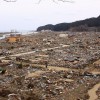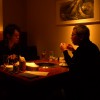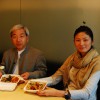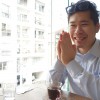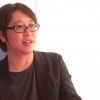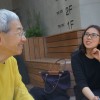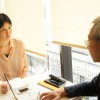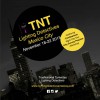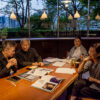Theme:Raising Creative Children
Interviewer: Rachel Nakayama
Rachel:Today I`d like to talk about children and design education. I think design education should be about developing free thought and the capacity to use free thought to solve problems. There is a weekly TV program on NHK called “Design あ;” I believe you had the opportunity make an appearance on the show. The program takes everyday objects and ideas and explains their design process in very simple animation, going right to the foundation or origin of that object. For example, “Why is a plastic bottle cap shaped like it is and why does it screw on?” My three kids and I really look forward to watching it every week.
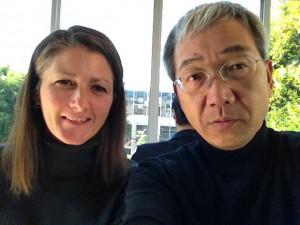
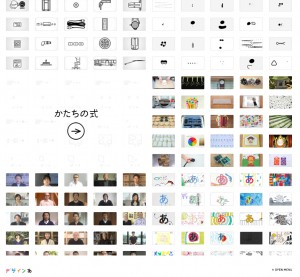
samples of the contents “Design A”
①one pair of formula、②My circle and square、③ design people 、④Everyone’s「Ah」
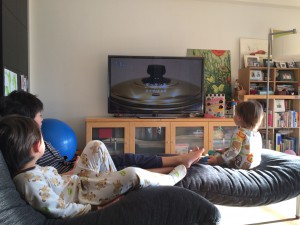
Saturday Morning:All three children are obsessed with A”Design A”
Mende:You and your kids wake up at 7:00 on a Saturday to watch the show? Pretty early for the weekend.
Rachel: Yes, we are early risers, but sometimes we sleep in and miss the show. Everything in the program, from music to color scheme to word choice is easy to understand and beautifully artistic. I think it`s an interface than to appeals to children and adults, alike.
Mende:You describe this program called “Design あ” using the word design, but I think it is more of asking “Why?” of everyday things. Asking questions and solving the mystery, is very important.
Rachel:Yes, you are right. At the end of the show, there is always an interview with a designer of some kind. The designer makes a suggestion, a kind of one-point piece of advice, about the process of design for the audience. For example, a woodworker, Ryuji Mitani, suggested “Make two piles. One of the things you use regularly and one of the things you hardly ever use. What are the differences? For example, I use this cup every day, but hardly ever use this cup. Why?” It is advice like this that is very easy to understand and, I feel, the real essence of this program. Learning to think for oneself and putting it into words to communicate. I think when one forms an opinion and then speaks it out loud, one`s hands naturally start moving and the mind is activated.
Mende:Yes, I think childhood education should not be about filling one`s head with facts and wisdom, but applying stimuli so children have the freedom to freely feel, think, brainstorm and dream. Discovering on one`s own is a very important experience. If the stimuli is applied in the right way, inherent traits and abilities will come dripping out of our children.
Rachel:I think the design process of free-thinking and progressing through trial and error to an end product is better suited to children than adults. After a certain point adults might get frustrated and give up.
Mende:Yes, maybe so! I thought the word design was a difficult concept for children to grasp so I have avoided the use of it up until now, but this might be what design education is all about. It seems like a fantastic opportunity to learn about aesthetics and free-thinking along with engineering and science at the same time.
Rachel: Yes. I feel that, in a broad sense of the word, this is what design is all about. The ability to solve problems.
Mende:At our Children`s Akari Workshops with the Lighting Detectives we discuss light, but also the importance of shadow. The children also experience dark places at the workshops, which is a very good stimulator!
Rachel:Children play differently at different ages. Design education might need to be adjusted to meet different needs at different ages. I think at a young age, preschool to 3rd grade, questioning an object`s origin and such helps build a sense of curiosity and develops the ability to problem solve.
Mende: “Design あ” programing is focused for an audience of children, but I think adults might find the program just as interesting. I think the producers want children to watch, but also want adults to have fun watching, too. The program is easy for children to understand, while also closing in on the origins of the process of design. Design has the ability to impress not only adults, but also children. The program`s creator, Taku Sato, is a graphic designer. I think “Designあ” just might be the basis of his design ideology.
Rachel:The program interface is so revolutionary! Even my 2 year old watches parts and seems interested in the short animation and music. Even if he doesn`t understand the jest of what is being said, other information stimulates his eyes and ears.
Mende:Maybe as lighting designers, we need to simplify our explanations, like we are trying to inspire a child. This type of approach might be more important.
Rachel:Yes, you might be right. Adults need to have fun, just like children because they are watch us for clues!
Mende: Teaching children needs to be interesting, fun, aesthetically beautiful, and inspiring.
Rachel:Design education for children sounds difficult, but with the right opportunity and freedom to be creative it might just naturally develop. Thank you for talking today.






